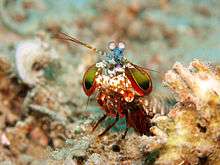Odontodactylus scyllarus
| Odontodactylus scyllarus | |
|---|---|
 | |
| Scientific classification | |
| Kingdom: | Animalia |
| Phylum: | Arthropoda |
| Subphylum: | Crustacea |
| Class: | Malacostraca |
| Order: | Stomatopoda |
| Family: | Odontodactylidae |
| Genus: | Odontodactylus |
| Species: | O. scyllarus |
| Binomial name | |
| Odontodactylus scyllarus (Linnaeus, 1758) | |
Odontodactylus scyllarus, known as the peacock mantis shrimp, harlequin mantis shrimp, painted mantis shrimp, or clown mantis shrimp, is a large mantis shrimp native to the Indo-Pacific from Guam to East Africa.[1]
In the saltwater aquarium trade, it is both prized for its attractiveness and considered by others to be a dangerous pest.
Description
O. scyllarus is one of the larger, more colourful mantis shrimps commonly seen, ranging in size from 3 to 18 cm (1.2 to 7.1 in).[1] They are primarily green in colour, with orange legs and leopard-like spots on the anterior carapace.[1]
Their ability to see circularly polarised light has led to studies to determine if the mechanisms by which their eyes operate can be replicated for use in reading CDs and similar optical information-storage devices.[2][3]
Ecology
Odontodactylus scyllarus is a burrower, constructing U-shaped holes in the loose substrate near the bases of coral reefs in water ranging from 3 to 40 metres (9.8 to 131.2 ft) deep.[1]
O. scyllarus is a smasher, with club-shaped raptorial appendages.[1] An active hunter, it prefers gastropods, crustaceans, and bivalves,[1] and will repeatedly smash its prey until it can gain access to the soft tissue for consumption. It is reported to have a "punch" of over 50 miles per hour (80 km/h). This is the fastest recorded punch of any living animal. The acceleration is similar to that in a .22 caliber handgun, with 340 pounds-force (1,500 N)[4] per strike. In addition, the surface of its appendages is made up of extremely dense hydroxyapatite, layered in a manner which is highly resistant to fracturing. Glass aquaria can be broken by them. The composition is being investigated for potential synthesis and engineering use.[5][6]
Aquaria
Some saltwater aquarists keep peacock mantis shrimp in captivity.[7] The peacock mantis is especially colourful and desired in the trade.
While some aquarists value peacock shrimp, others consider them harmful pests because they are voracious predators which eat other desirable inhabitants of the tank. Some of the largest specimens can break aquarium glass by striking it, and can do further damage by burrowing in live rock.
The live rock with mantis shrimp burrows are actually considered useful by some in the marine aquarium trade and are often collected. It is not uncommon for a piece of live rock to convey a live mantis shrimp into an aquarium. Once inside the tank, they may feed on fish, and other inhabitants. They are notoriously difficult to catch when established in a well-stocked tank,[8] and there are accounts of them breaking glass tanks, it should be noted that whilst stomatopods do not eat coral, the smashers can damage it if they wish to make a home within it.[9]
References
- 1 2 3 4 5 6 Roy Caldwell. "Species: Odontodactylus scyllarus". Roy's List of Stomatopods for the Aquarium. Retrieved July 18, 2006.
- ↑ John Roach (June 27, 2011). "Shrimp eyes inspire optical tech". MSNBC. Retrieved June 28, 2011.
- ↑ Yi-Jun Jen, Akhlesh Lakhtakia, Ching-Wei Yu, Chia-Feng Lin, Meng-Jie Lin, Shih-Hao Wang & Jyun-Rong Lai (2011). "Biologically inspired achromatic waveplates for visible light". Nature Communications. 2: 363. Bibcode:2011NatCo...2E.363J. doi:10.1038/ncomms1358. PMID 21694711.
- ↑ "Extreme impact and cavitation forces of a biological hammer: strike forces of the peacock mantis shrimp Odontodactylus scyllarus". 208 (Pt 19). October 2005: 3655–64. doi:10.1242/jeb.01831. PMID 16169943.
- ↑ Sarah Everts (2012). "How a peacock shrimp packs a punch: layered structure is behind animal's resilient club". Chemical & Engineering News. 90 (24): 6.
- ↑ James C. Weaver, Garrett W. Milliron, Ali Miserez, Kenneth Evans-Lutterodt, Steven Herrera, Isaias Gallana, William J. Mershon, Brook Swanson, Pablo Zavattieri, Elaine DiMasi & David Kisailus (2012). "The stomatopod dactyl club: a formidable damage-tolerant biological hammer". Science. 336 (6086): 1275–1280. Bibcode:2012Sci...336.1275W. doi:10.1126/science.1218764. PMID 22679090.
- ↑ A Load of Learnin' About Mantis Shrimps, by James Fatherree, in ReefKeeping online magazine.
- ↑ Nick Dakin (2004). The Marine Aquarium. London: Andromeda. ISBN 1-902389-67-0.
- ↑ April Holladay (September 1, 2006). "Shrimp spring into shattering action". USA Today.
External links
| Wikimedia Commons has media related to Odontodactylus scyllarus. |